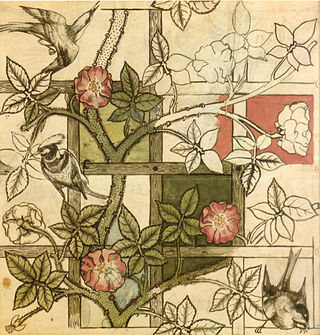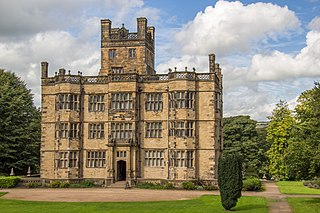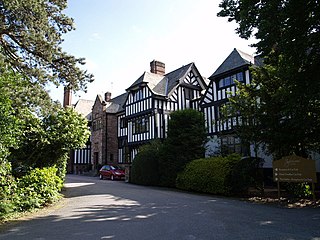
The Arts and Crafts movement was an international trend in the decorative and fine arts that developed earliest and most fully in the British Isles and subsequently spread across the British Empire and to the rest of Europe and America.

Chipping Campden is a market town in the Cotswold district of Gloucestershire, England. It is notable for its terraced High Street, dating from the 14th century to the 17th century.

The legacy of a family's passion for Victorian art and design, Wightwick Manor is a Victorian manor house located on Wightwick Bank, Wolverhampton, West Midlands, England. Owned by the National Trust since 1937, the Manor and its grounds are open to the public. It is one of only a few surviving examples of a house built and furnished under the influence of the Aesthetic movement and Arts and Crafts movement. The house is in a grand version of the half-timbered vernacular style, of which the most famous original example is Little Moreton Hall over 40 miles to the north, in Cheshire.

Kelmscott Manor is a limestone manor house in the Cotswolds village of Kelmscott, in West Oxfordshire, southern England. It dates from around 1570, with a late 17th-century wing, and is listed Grade I on the National Heritage List for England. It is situated close to the River Thames. The nearest town is Lechlade-On-Thames.

Standen is an Arts and Crafts house located to the south of East Grinstead, West Sussex, England. The house and its surrounding gardens belong to the National Trust and are open to the public. It is a Grade I listed building.

Richmond Green is a recreation area near the centre of Richmond, a town of about 20,000 inhabitants situated in south-west London. Owned by the Crown Estate, it is leased to the London Borough of Richmond upon Thames. The Green, which has been described as "one of the most beautiful urban greens surviving anywhere in England", is roughly square in shape and its open grassland, framed with broadleaf trees, extends to roughly twelve acres. On the north-east side there is also a smaller open space called Little Green. Richmond Green and Little Green are overlooked by a mixture of period townhouses, historic buildings and municipal and commercial establishments including the Richmond Lending Library and Richmond Theatre.

Gawthorpe Hall is an Elizabethan country house on the banks of the River Calder, in Ightenhill, a civil parish in the Borough of Burnley, Lancashire, England. Its estate extends into Padiham, with the Stockbridge Drive entrance situated there. The Elizabethan house is traditionally attributed to Robert Smythson. In the mid-19th century, the hall was rebuilt by Charles Barry, the architect of the Houses of Parliament. Since 1953 it has been designated a Grade I listed building. In 1970 the 4th Lord Shuttleworth gave the hall to the National Trust, with a 99-year lease to Lancashire County Council. Both bodies jointly administer the hall and in 2015 the council provided £500,000 funding for restoration work on the south and west sides of the house.

Edgar Wood was a British architect, artist and draftsman who practised from Manchester at the turn of the 20th century and gained a considerable reputation in the United Kingdom. He was regarded as a proponent of the Arts and Crafts movement which was prevalent between 1860 and 1910.

Clouds House, also known simply as Clouds, is a Grade II* listed building at East Knoyle in Wiltshire, England. Designed by Arts and Crafts architect Philip Webb for Percy Wyndham and his wife Madeline, it was first completed in 1886, but an 1889 fire necessitated its rebuilding, finished in 1891. Clouds was Webb's grandest design. It became a centre of social activity for the intellectual group known as The Souls, and was frequented by artists such as Edward Burne-Jones and politicians like Arthur Balfour.
Detmar Jellings Blow was a British architect of the early 20th century, who designed principally in the arts and crafts style. His clients belonged chiefly to the British aristocracy, and later he became estates manager to the Duke of Westminster.

Winterbourne Botanic Garden is a heritage site and botanic garden in Edgbaston, Birmingham, England. It is owned by the University of Birmingham.

All Saints' is a church on Jesus Lane in central Cambridge, England, which was built by the architect George Frederick Bodley. The church was constructed in stages between 1863 and 1870 and is a notable example of English Gothic Revival style. It was designated Grade I listed building status in 1950. It was vested in the Churches Conservation Trust in 1981. Opening times vary and visitors should contact the Churches Conservation Trust to confirm current arrangements.

Inglewood is a house to the north-west of the village of Ledsham, Cheshire, England. It was built in 1909, but is dated 1915. The house was built for Frederick H. Fox, a Liverpool millionaire who made his fortune in marine insurance. It was later one of the seats of the Gordon family. As of 2011 it is a hotel called Inglewood Manor Hotel. The house is mainly half-timbered, with stone dressings, and brick chimneys decorated with diapering. It is roofed with Lakeland slate. Its architectural style is late Arts and Crafts. The house has a rectangular plan, with three fronts in two and three storeys. The entrance is on the east front, which has eight bays; the south and west fronts each have five bays. On the south side is a balcony overlooking the gardens. The house is recorded in the National Heritage List for England as a designated Grade II listed building. Also listed Grade II are the south and west terrace walls of the garden, and the east terrace walls and a pergola.

7 Hammersmith Terrace is an historic house in the London borough of Hammersmith and Fulham, England, and the former home of English engraver and printer Emery Walker. Walker was an important figure in the English Arts and Crafts movement, and a close friend of textile designer William Morris, who lived nearby. During his life, Walker furnished the home in an Arts and Crafts style, reflecting his friendships with Morris and others.
Frederick Richard Leach (1837–1904) was an English master decorator, mural and stained glass painter based in Cambridge. He worked with the architects George Frederick Bodley and George Gilbert Scott Junior, the designer William Morris and the church craftsman Charles Eamer Kempe on many Victorian Gothic revival churches, Cambridge college interiors and church restorations.

The Manor Church Centre was a combined church and church hall on Seabank Road, Egremont, Merseyside, England. It was built in 1907–08 as Egremont Presbyterian Church, later became Egremont United Reformed Church, and in 1994 joined with a local Methodist church to become the Manor Church Centre. The church was designed by Briggs, Wolstenholme and Thornley, is constructed in sandstone, and is in a mixture of Arts and Crafts and Gothic Revival styles. The church is notable for the stained glass in its windows. The church and hall are recorded in the National Heritage List for England as a designated Grade II listed building. The church was closed c. 2011 as a result of dwindling congregation numbers.

Ashorne Hill House, Ashorne, Warwickshire, England is a late Victorian country house built for Arthur and Ethel Tree by the architect Edward Goldie between 1895 and 1897. Arthur Tree, son of the American lawyer and diplomat, Lambert Tree, and his wife, the Marshall Field's heiress, had moved to England in the later 19th century and established themselves as country gentry. They purchased the Ashorne estate in 1892 and Goldie was commissioned to build a new house in the Arts & Crafts style. The house, now a management training college, is a Grade II listed building.

Chiswick High Road is the principal shopping and dining street of Chiswick, a district in the west of London. It was part of the main Roman road running west out of London, and remained the main road until the 1950s when the A4 was built across Chiswick. By the 19th century the road through the village of Turnham Green had grand houses beside it. The road developed into a shopping centre when Chiswick became built up with new streets and housing to the north of Old Chiswick, late in the 19th century. There are several listed buildings including public houses, churches, and a former power station, built to supply electricity to the tram network.

The architecture of Bedford Park in Chiswick, West London, is characterised largely by Queen Anne Revival style, meaning an eclectic mixture of English and Flemish house styles from the 17th and 18th centuries, with elements of many other styles featuring in some of the buildings.


















